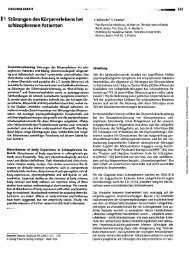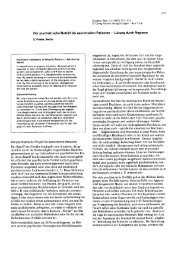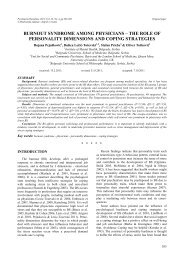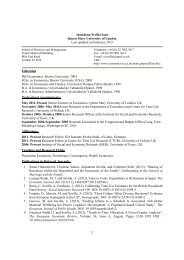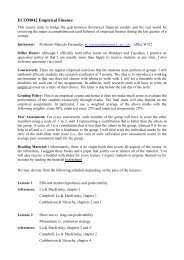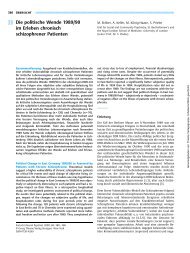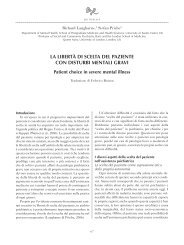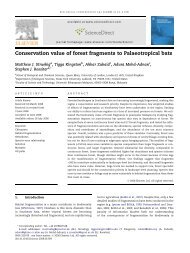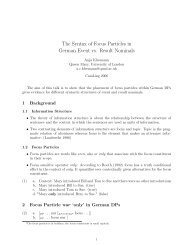Proofs - Personal Webspace for QMUL - Queen Mary, University of ...
Proofs - Personal Webspace for QMUL - Queen Mary, University of ...
Proofs - Personal Webspace for QMUL - Queen Mary, University of ...
Create successful ePaper yourself
Turn your PDF publications into a flip-book with our unique Google optimized e-Paper software.
studies [8,6,27]. Commonly suggested methods <strong>of</strong> building trust<br />
through repeated interactions with the target minority population<br />
[11,19,25] include involving key persons <strong>of</strong> the targeted<br />
underrepresented community from areas <strong>of</strong> religion, politics<br />
and the healthcare system [2,3,26], utilizing media (e.g., radio<br />
and newspaper) and cultural centres [2,9,14], hiring research<br />
staff <strong>of</strong> the targeted population and intercultural education <strong>of</strong><br />
the fi eld team [2,11,26], providing tangible and non- tangible<br />
incentives (e.g., money, bus and taxi tokens, gift certifi cates<br />
<strong>for</strong> food, movies or videos) [15,26] and disclosing the benefi ts<br />
and risks <strong>of</strong> study participation [4,11,26]. The present paper<br />
provides in<strong>for</strong>mation about attitudes towards health research<br />
studies and potential participation barriers as well as adequate<br />
solutions <strong>for</strong> the successful recruitment <strong>of</strong> individuals with<br />
Turkish migration backgrounds into health research studies.<br />
2. Subjects and methods<br />
2.1. Recruitment and conduction<br />
From March to June 2010, a total <strong>of</strong> four semi- structured<br />
focus groups were conducted with adults with Turkish migration<br />
backgrounds who resided in Hamburg. The participants<br />
were recruited by the research staff using invitations printed<br />
in German and Turkish that were entitled “Your opinion is<br />
important to us!” and included a brief explanation <strong>of</strong> the<br />
focus groups. The aim was to include eight individuals per<br />
focus group [12] between the ages <strong>of</strong> 18 and 65 years. As a<br />
result <strong>of</strong> last- minute cancellations and attendance without<br />
prior notifi cation, the number <strong>of</strong> participants varied between 7<br />
and 12 individuals. The majority <strong>of</strong> the participants were<br />
accompanied by friends or relatives. The mean duration <strong>of</strong><br />
the meetings was 100 minutes, and a compensation <strong>of</strong> 10 €<br />
was <strong>of</strong>fered to each participant. The focus groups were held in<br />
Turkish by a female bilingual psychologist who was assisted<br />
by a female bilingual student.<br />
Prior to the focus groups, four experts (two with Turkish<br />
migration backgrounds and two with broad experiences in<br />
fi eld research) were consulted to evaluate key aspects when<br />
conducting focus groups with individuals with Turkish migration<br />
backgrounds. The experts indicated that this type <strong>of</strong> investigation<br />
could be an unfamiliar situation <strong>for</strong> the majority <strong>of</strong> the<br />
target group and may lead to uncertainties or inhibitions in open<br />
discussion. Furthermore, the experts recommended not video or<br />
tape recording the participants <strong>for</strong> the same reasons. To initiate<br />
communication between the participants, they were asked to<br />
discuss the fi rst two questions in pairs <strong>of</strong> two and noted their<br />
ideas on coloured presentation cards. Subsequently, the cards<br />
were attached to a pin board, and the topics were discussed as<br />
a group. Additionally, written notes <strong>of</strong> the discussion were kept<br />
(protocols).<br />
The procedure <strong>of</strong> the focus groups was semi- structured and<br />
included a question guideline. Initially, the participants were<br />
asked <strong>for</strong> their language preferences (German or Turkish) and<br />
were in<strong>for</strong>med that their attendance was voluntary. After an<br />
introduction <strong>of</strong> the attendees and a brief presentation <strong>of</strong> the<br />
background and aim <strong>of</strong> the research study, the participants were<br />
asked the following questions:<br />
D. Dingoyan et al. / European Psychiatry 27 (2012) / supplement n°2 /S4-S9 S5<br />
• Perceived barriers: What do you think are reasons <strong>for</strong> less willingness<br />
<strong>of</strong> individuals with Turkish migration backgrounds to<br />
participate in research studies? With this question, an example<br />
was given that referred to enrolment challenges <strong>of</strong> women<br />
with Turkish migration backgrounds in a current survey 1 .<br />
• Recommendations: How can individuals with Turkish<br />
migration backgrounds be motivated to participate in future<br />
research studies?<br />
• Contacting: Can direct personal contact (such as home visits)<br />
increase the willingness to participate in research studies?<br />
• Tangible incentive: What amount <strong>of</strong> money do you consider<br />
as appropriate <strong>for</strong> a three- hour interview?<br />
• Key figures: Can well- known public figures increase the<br />
participation <strong>of</strong> individuals with migration backgrounds in<br />
research studies?<br />
Furthermore, two questionnaires were completed. One<br />
questionnaire asked <strong>for</strong> socio- demographic data, and the second<br />
questionnaires surveyed the popularity <strong>of</strong> key fi gures with<br />
Turkish migration backgrounds (on a scale from 0=unpopular<br />
to 10= popular). At the end <strong>of</strong> the meetings, feedback was given<br />
by each participant. Because <strong>of</strong> the different group sizes and<br />
the limited time frame, the questions concerning the perceived<br />
barriers and the contacting were excluded from two different<br />
focus groups.<br />
2.2. Content analysis<br />
The qualitative content analysis <strong>of</strong> the superscripted presentation<br />
cards and documented statements was based on the<br />
method <strong>of</strong> Mayring [18]. The protocols and transcriptions <strong>of</strong> the<br />
presentation cards were translated into German by the bilingual<br />
psychologist who moderated the focus groups. In the fi rst stage <strong>of</strong><br />
the analysis, all statements were paraphrased by one person. In a<br />
further stage, two raters independently grouped content coherent<br />
statements to inductively <strong>for</strong>m appropriate categories. Typical<br />
example sentences and commonly used terms (keywords) were<br />
extracted and defi ned <strong>for</strong> each category. In the case <strong>of</strong> inter- rater<br />
divergence, the categories were discussed by both raters and<br />
coding rules were specifi ed. Subsequently, all categories were<br />
revised and compared to the original non- paraphrased statements.<br />
Finally, the statements were counted within each category<br />
to indicate commonly mentioned topics among all focus groups.<br />
<strong>Pro<strong>of</strong>s</strong><br />
3. Results<br />
3.1. Sample characteristics<br />
A total <strong>of</strong> 37 individuals with Turkish migration backgrounds<br />
and a mean age <strong>of</strong> 44 years participated in the focus groups.<br />
Although it was intended to recruit an equal number <strong>of</strong> men and<br />
women in the focus groups, more women (78%) than men (22%)<br />
participated. Twelve participants born in Turkey did not answer<br />
the question about their year <strong>of</strong> migration, without indication<br />
<strong>of</strong> reasons. Further in<strong>for</strong>mation concerning the sample’s characteristics<br />
is illustrated in table 1.<br />
1 personal note from Marion Aichberger (2011)




